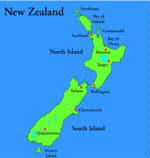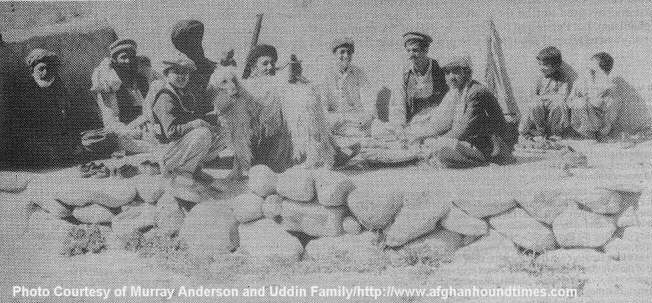An Introduction To The Breed
(Lyall Payne, Bletchley Hall, NZ)
The Afghan Hound
This dramatic photo of the Uddin family was taken in 1981, two years after Russian tanks rolled into Afghanistan. The stark reality of guns at the ready, a family at war and their beloved Afghan Hound is indicative of this breed in its native land today. Two of the Uddir family brothers run a shop selling jewelry and other items from their homeland in Auckland's exclusive Parnell shopping center. Just recently this dog died. "We gave him a grave," said the brothers. Such is the respect this breed has held for thousands of generations by Afghan tribes people. Other breeds and cross-breeds, normally despised, would not be accorded such honour.
I wish to acknowledge the assistance of everyone who has contributed to this supplement, noted with their articles. In addition to those who supplied photographs, my thanks to Desiree Crysell for compiling the photograph montage pages.
An Introduction To The Breed
By Lyall Payne
Native to Afghanistan. Early breed history is shrouded and frequently clouded in myth and legend. It is an ancient breed, closely related to other sighthounds, we recognize today, such as the Saluki and Greyhound.
It was only in this century, however, that the breed acquired a singularly recognized name - the Afghan Hound, ascribed to it by fanciers who took the first specimens over the borders of Afghanistan and the surrounding terrain, and introduced the breed to the Western world.
All these fanciers were in some way connected with the British occupation of India and Afghanistan. Soldiers, their families, war correspondents or people connected in some way with the departing British troops leaving Afghanistan, Northern India and the area we now know as Pakistan, during the 1920's and 1930's.
The Afghan hound is therefore a very recent introduction to the rest of the world. This, despite the fact that the breed has long been known under a variety of names of which, incidentally, was "the Afghan hound" for thousands of years in its native lands.
I suspect it has a close relationship to the Saluki and other Oriental Greyhound breeds - some long since vanished and it is questionable just what claims can be rightly attributable to the distinctly different breeds we know today.
Tazi, Khalagh, Persian Greyhound, Saluqi, Sloughi, Baluchi Hound, Kurrum Valley Hound, Barukhzy Hound - all names for eastern greyhound type breeds and perhaps the same ones in some cases.
Afghanistan and its immediate surrounds has seldom experienced peace. The famed names of Alexander the Great, Genghis Khan and Tamerlane along with their massive armies scourged the lands. Britain maintained a protectorate there from 1839 to 1921. The military took over in 1973 and in 1979 Russian troops arrived; only recently beginning to leave. Perhaps as a legacy of its history, the people of Afghanistan are comprised of regions of miscellaneous tribes, mobile and of varied ethnic and religious composition, incorporating many of the influences of the great armies and religions that periodically swept the country.
Northern Afghanistan is remote and rugged, mountainous and snowclad in winter. Other areas are desert-like-plains, searing daytime temperatures that can plummet to freezing level at night.
The Afghan fanciers of the 1920's who introduced the breed to the west were as colourful with the written words as many of its enthusiasts are today. With some exceptions, the breed was taken to England by two very opposing camps. With a few exceptions, it was via these dogs that the breed was established in other countries of the world.
It is arguable just what significance the two camps of difference have to today's Afghan hound. I feel it is very much a part of the breeds history. Major G Bell-Murray (ex Indian Army) gathered many hounds for Miss Jean Manson who lived in Scotland. These dogs were known as Bell Murray type hounds. Mary Amps - wife of Major Pat Amps gathered another group of hounds. These dogs became known as Ghazni type hounds.
Letters written by Maj. Bell-Murray and Mrs. Amps in the 1930's, and a further article concerning Man Amps written in 1976 have been included to demonstrate the nature of the early enthusiasts, the vast and sometimes misleading claims, but whose legacies remain with the breed today
.
Index Page NZ Articles
Library Of Articles/Main Menu Toolbar
Whats New Page
|

